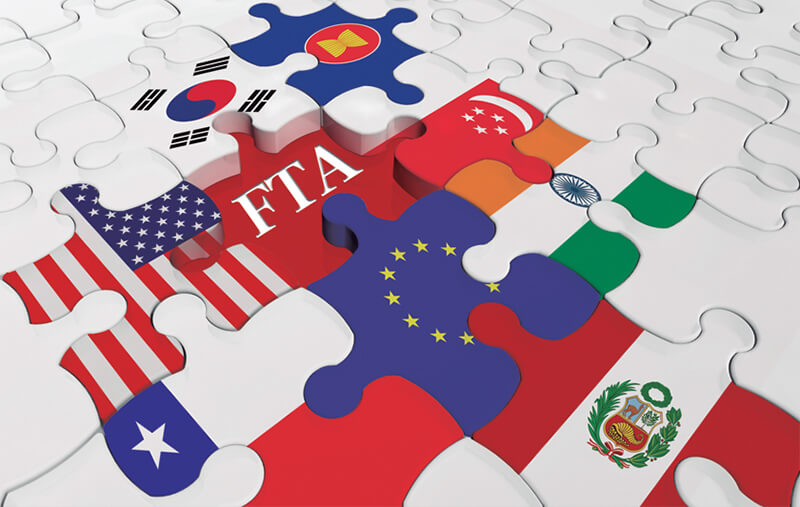View News
India-and-Its-Free-Trade-Agreements-FTAs

India and Its Free Trade Agreements (FTAs)
Introduction
In recent years, India has been actively pursuing Free Trade Agreements (FTAs) with various countries worldwide. These agreements are primarily designed to eliminate or reduce trade barriers, tariffs, and protective quotas that hinder the free flow of goods and services between the signatory countries. While FTAs can offer significant benefits, such as increased trade, job creation, and economic growth, they also pose potential challenges.
Benefits of FTAs
Export Opportunities
FTAs can significantly reduce or eliminate barriers to India's exports, making them more competitive in foreign markets. This can lead to increased export volumes, boost economic activity, and create jobs in export-oriented sectors.
Access to New Markets
FTAs open up new markets and customers that were previously inaccessible to Indian companies, thereby diversifying their export portfolio and reducing dependence on traditional markets.
Foreign Direct Investment (FDI)
A more open trade environment can attract foreign investors targeting the Indian market. FDI brings capital, technology, and expertise, leading to job creation and innovation across various sectors.
Increased Efficiency and Innovation
Increased competition from FTAs can drive domestic firms to become more efficient and innovative to survive. This can result in better product quality, lower prices for consumers, and a more vibrant economy.
Potential Challenges
Job Losses in Certain Industries
Increased competition from low-priced imports can lead to job losses in industries that are not well-positioned to compete effectively, particularly in labor-intensive sectors such as textiles and agriculture.
Trade Deficit
If the increase in imports due to an FTA outpaces the growth in exports, it can lead to a trade deficit for India, resulting in an outflow of foreign exchange.
Import Dependence
Relying heavily on imports for essential items can expose India to external shocks and price fluctuations in the global market.
Unequal Benefits
The benefits of FTAs may not be evenly distributed across sectors and regions. Some sectors and regions may gain more than others, potentially leading to increased income inequality.
Considerations for India's Free Trade Agreements
Government Policies
The government can support and modernize domestic industries through policies such as skill development programs, infrastructure upgrades, and temporary tariff protection for sensitive sectors.
Focus on Skilled Workforce
Investing in education and skill development can equip Indians with the capabilities needed to thrive in a globalized economy.
Reskilling and Training
Reskilling and training workers from sectors adversely affected by imports under FTAs can help them find employment in export-oriented industries and new opportunities.
Strategic Negotiation
During FTA negotiations, it is crucial to safeguard fair trade practices, protect sensitive sectors, and ensure suitable market access for key exports.
Overall, a balanced approach to FTAs is necessary. India can benefit from increased trade, investment, and access to new markets while minimizing job losses and protecting vulnerable sectors through strategic policies and workforce investments.
India's Recent Free Trade Agreements
India–European Free Trade Association Trade and Economic Partnership Agreement
This agreement is expected to increase trade value by $100 billion over 15 years through mutually beneficial investments in pharma, chemicals, food processing, and engineering. India will simplify customs procedures, provide market access, and lower import tariffs on industrial goods from EFTA countries, including Iceland, Liechtenstein, Norway, and Switzerland. The agreement is set to take effect in 2025.
Australia-India Economic Cooperation and Trade Agreement
Effective from December 29, 2022, this agreement will make over 85% of Australian goods exports to India duty-free, with the figure expected to reach 90% by January 1, 2026.
India-Mauritius CECPA
This Comprehensive Economic Cooperation and Partnership Agreement has been in effect since 2021.
India-UAE CEPA
Operational since 2022, this agreement aims to strengthen economic ties between India and the UAE.
Conclusion
The impact of India's existing and potential FTAs on the Indian economy is complex. While some sectors have seen increased exports, others have faced job losses due to import competition. The effectiveness of FTAs depends on implementation and the development of domestic industries, infrastructure, and a skilled workforce.
Therefore, careful negotiation, effective implementation, and a focus on domestic reforms are crucial to maximizing the benefits of FTAs for the Indian economy as a whole.
Citations
-
Team, I. (2024b, June 4). Free Trade Agreement (FTA): definition, how it works, and example. Investopedia. Investopedia
-
Team, E., & Team, E. (2024, March 27). Free trade Agreements (FTAs): pros and cons - UPSC Economy. Blog -. Edukemy
-
Press Trust of India & Business Standard. (2023, August 14). India looking at FTAs for strategic considerations also: Commerce Secretary. Business Standard
-
Welcome to Department of Commerce, Government of India. (2024, June 7). Trade Agreements - Mcommerce. Mcommerce
Unlock the Potential of Legal Expertise with LegalMantra.net - Your Trusted Legal Consultancy Partner”
Article Compiled by:-
~Sura Anjana Srimayi
(LegalMantra.net Team)
Disclaimer: Every effort has been made to avoid errors or omissions in this material in spite of this, errors may creep in. Any mistake, error or discrepancy noted may be brought to our notice which shall be taken care of in the next edition In no event the author shall be liable for any direct indirect, special or incidental damage resulting from or arising out of or in connection with the use of this information Many sources have been considered including Newspapers, Journals, Bare Acts, Case Materials , Charted Secretary, Research Papers etc.

